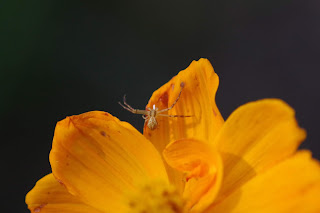Backyard Co-Bug of the Day #1:
Pearl crescent butterfly. If I were to go back through the years of my blog, I would probably find almost this exact picture every year at some point around this time of year: a pearl crescent butterfly on these flowers (which I think are another kind of aster), taken on the rocks in front of my house in late September or early October.
Wasp photobombed
Check out that curly proboscis.
Backyard Co-Bug of the Day #2:
Without looking it up I am going to say this is an American dagger moth. What's kind of interesting is that I haven't seen any American dagger moth caterpillars this year. I have seen a lot of banded tussock moth caterpillars, and lately quite a few spotted apatelodes caterpillars, which are both species I used to get confused with the American dagger moth caterpillar. Also ironic is that I don't know if I have ever seen banded tussock moths or spotted apatelodes moths–but maybe I have, I think they are both boring, brown moths that look like a million other boring, brown moths. [Edit: I just looked them up, and I have seen banded tussock moths, and they are pretty cool. However, I have seen a LOT of banded tussock moth caterpillars, but not very many banded tussock moths. I am not sure if I have seen a spotted apatelodes moth. It is pretty cool looking, but there are several similar moths, so I don't know if that is what I have seen] But this, you say, is also a boring, brown moth? Well, it is quite interesting in one respect, which is that it is rather large–at least two inches from head to wingtip. And it's somewhat disappointing to find it on the side of the house because I don't get to show you how well it blends in on tree trunks with that pattern.
Backyard Co-Bug of the Day #3:
Just kidding. Although, it is in this picture. But I got better pictures of it.
Cherry dagger moth. Which I have never even heard of. I just looked up a picture of the moth, and it is a boring, brown moth. What I found out from my caterpillar book (Caterpillars of Eastern North America by David L. Wagner) is that this caterpillar is bright green with a yellow stripe down its back in the instar just before this one, which is the last one. That's pretty interesting.
More Lepidoptera:
A monarch showed up today! A female. She must be on her way to Mexico. Her colors were vibrant, and her wings in good shape, so she looks like she has only recently eclosed. She's got a long journey ahead of her.
Photobombed by a bee–can you see it?
Cabbage white:
Skipper
That was four butterflies; the other two I only saw, flying among the trees, and I did not get pictures. I didn't get a good enough look to identify them, either, but one looked like an eastern tiger swallowtail, and the other's markings looked like a mourning cloak, but it seemed too small for that.
Banded tussock moth. After being everywhere recently, the last two days I have only found one.
Spotted apatelodes:
I don't think I ever knew before that they have green skin.
I did know that they have red/pink feet.
I could not find the last of the contracted datanas on the oak tree out front, but I did find this on the back of the house. However, I am not sure this is a contracted datana, because it doesn't have an orange prothoracic shield, it has a black one. I did find one in the book with a black prothoracic shield, angus's datana, but I can't tell if the stripes are right.
Other Bugs:
I said it was a Lepidoptera day, but by numbers it was definitely a Hymenoptera day. I just didn't get pictures of most of them (and by most I mean I got pictures of about 2 percent). But here's a wasp on asters.
Based on some things I have read recently, a lot of the wasps around in the fall are males that have been cast out and are desperately looking for food. I saw a lot of them on or buzzing around the leaves of trees today (this one is on a bittersweet leaf).
I saw only one insect on the autumn joy sedum today, this bumblebee.
Male mosquito, which you can tell from its feathery antennae. They eat only flower nectar.
Female mosquito, with thin antennae. I don't know if these are the same species. I also hope from the fact that they were active in the middle of the afternoon that they were not the species carrying eastern equine encephalitis, which has infected two people in the state so far this year, and killed one. Female mosquitoes are the only ones that bite, needing the protein to be able to lay their eggs, though they mostly feed on flower nectar.
Nowadays when I pull out the rain gauge to empty it there is nearly always at least one cricket under or behind it. Today there were two, and this one let me take its picture.
There's something odd going on with its wings. It almost looks like something is stuck under its elytra.
Stinkbug nymph
I think these are green lacewing eggs.
Arachnid Appreciation:
.
.
.
.
.
.
.
.
.
.
.
.
Flower crab spider dining on what I think is a whitefly.
Nursery web spider with something small as prey


































No comments:
Post a Comment